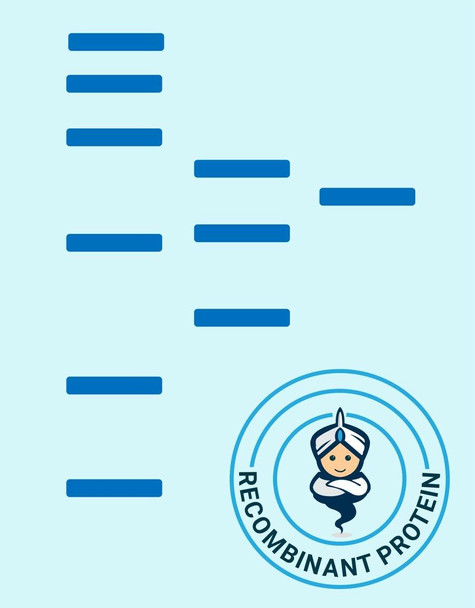Description
| Product Name: | Human PSME2 Recombinant Protein |
| Product Code: | RPPB4324 |
| Size: | 10µg |
| Species: | Human |
| Target: | PSME2 |
| Synonyms: | Proteasome (prosome, macropain) activator subunit 2 (PA28 beta), PA28beta, Activator of multicatalytic protease subunit 2, Proteasome activator 28 subunit beta, 11S regulator complex subunit beta, PA28B, REG-beta, cell migration-inducing protein 22, MCP activator 31-kD subunit, proteasome activator complex subunit 2, Proteasome activator hPA28 subunit beta. |
| Source: | Escherichia Coli |
| Physical Appearance: | Sterile Filtered colorless solution. |
| Formulation: | The PSME2 solution (1mg/ml) contains 20mM Tris-HCl buffer (pH 8.0), 0.1M NaCl, 1mM DTT, 0.1mM PMSF and 20% glycerol. |
| Stability: | Store at 4°C if entire vial will be used within 2-4 weeks. Store, frozen at -20°C for longer periods of time. For long term storage it is recommended to add a carrier protein (0.1% HSA or BSA).Avoid multiple freeze-thaw cycles. |
| Purity: | Greater than 95% as determined by SDS-PAGE. |
| Amino Acid Sequence: | MGSSHHHHHH SSGLVPRGSH MAKPCGVRLS GEARKQVEVF RQNLFQEAEE FLYRFLPQKI IYLNQLLQED SLNVADLTSL RAPLDIPIPD PPPKDDEMET DKQEKKEVPK CGFLPGNEKV LSLLALVKPE VWTLKEKCIL VITWIQHLIP KIEDGNDFGV AIQEKVLERV NAVKTKVEAF QTTISKYFSE RGDAVAKASK ETHVMDYRAL VHERDEAAYG ELRAMVLDLR AFYAELYHII SSNLEKIVNP KGEEKPSMY |
PSME2 is an IFN-gamma inducible proteasome activator essential for production of several key histocompatibility (MHC) class I antigens. Downregulation of PSME2 causes unusual proteasome activation and is connected to the development of intimal hyperplasia (IH) in animal models.
PSME2 Human Recombinant produced in E.coli is a single, non-glycosylated polypeptide chain containing 259 amino acids (1-239) and having a molecular mass of 29.5 kDa.PSME2 is fused to a 20 amino acid His-tag at N-terminus & purified by proprietary chromatographic techniques.
| UniProt Protein Function: | PSME2: Implicated in immunoproteasome assembly and required for efficient antigen processing. The PA28 activator complex enhances the generation of class I binding peptides by altering the cleavage pattern of the proteasome. Heterodimer of PSME1 and PSME2, which forms a hexadimeric ring. By IFNG/IFN-gamma. Belongs to the PA28 family. |
| UniProt Protein Details: | Protein type:Protease; Proteasome complex Chromosomal Location of Human Ortholog: 14q11.2 Cellular Component: cytoplasm; cytosol; membrane; nucleoplasm; proteasome complex Biological Process: anaphase-promoting complex-dependent proteasomal ubiquitin-dependent protein catabolic process; antigen processing and presentation of exogenous peptide antigen via MHC class I, TAP-dependent; MAPKKK cascade; negative regulation of ubiquitin-protein ligase activity during mitotic cell cycle; positive regulation of ubiquitin-protein ligase activity during mitotic cell cycle; proteasomal ubiquitin-dependent protein catabolic process; protein polyubiquitination; regulation of amino acid metabolic process; regulation of mRNA stability; stimulatory C-type lectin receptor signaling pathway; T cell receptor signaling pathway; tumor necrosis factor-mediated signaling pathway; Wnt receptor signaling pathway, planar cell polarity pathway |
| NCBI Summary: | The 26S proteasome is a multicatalytic proteinase complex with a highly ordered structure composed of 2 complexes, a 20S core and a 19S regulator. The 20S core is composed of 4 rings of 28 non-identical subunits; 2 rings are composed of 7 alpha subunits and 2 rings are composed of 7 beta subunits. The 19S regulator is composed of a base, which contains 6 ATPase subunits and 2 non-ATPase subunits, and a lid, which contains up to 10 non-ATPase subunits. Proteasomes are distributed throughout eukaryotic cells at a high concentration and cleave peptides in an ATP/ubiquitin-dependent process in a non-lysosomal pathway. An essential function of a modified proteasome, the immunoproteasome, is the processing of class I MHC peptides. The immunoproteasome contains an alternate regulator, referred to as the 11S regulator or PA28, that replaces the 19S regulator. Three subunits (alpha, beta and gamma) of the 11S regulator have been identified. This gene encodes the beta subunit of the 11S regulator, one of the two 11S subunits that is induced by gamma-interferon. Three beta and three alpha subunits combine to form a heterohexameric ring. Six pseudogenes have been identified on chromosomes 4, 5, 8, 10 and 13. [provided by RefSeq, Jul 2008] |
| UniProt Code: | Q9UL46 |
| NCBI GenInfo Identifier: | 296453017 |
| NCBI Gene ID: | 5721 |
| NCBI Accession: | Q9UL46.4 |
| UniProt Secondary Accession: | Q9UL46,Q15129, |
| UniProt Related Accession: | Q9UL46 |
| Molecular Weight: | 27,402 Da |
| NCBI Full Name: | Proteasome activator complex subunit 2 |
| NCBI Synonym Full Names: | proteasome activator subunit 2 |
| NCBI Official Symbol: | PSME2�� |
| NCBI Official Synonym Symbols: | PA28B; REGbeta; PA28beta�� |
| NCBI Protein Information: | proteasome activator complex subunit 2 |
| UniProt Protein Name: | Proteasome activator complex subunit 2 |
| UniProt Synonym Protein Names: | 11S regulator complex subunit beta; REG-beta; Activator of multicatalytic protease subunit 2; Proteasome activator 28 subunit beta; PA28b; PA28beta |
| Protein Family: | Proteasome activator complex |
| UniProt Gene Name: | PSME2�� |
| UniProt Entry Name: | PSME2_HUMAN |










